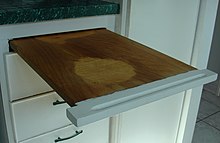Cutting board
A cutting board is a mat for cutting food . It is used to ensure that the table is neither damaged nor the knife blunted when cutting . A special form of the cutting board is the snack board , which is a conventional cutting board , but is primarily used as dinnerware for snacks and only secondarily for food preparation.
Cutting boards are manufactured in various dimensions: small boards for covering individual bread slices, approx. 15 × 21 cm ("bread board", "breakfast board"), up to boards that can accommodate large pieces of meat, approx. 50 × 60 cm. Some boards are provided with a circumferential "juice groove" to prevent liquids from flowing off the board.
Some cutting boards are provided with baseboards or are so thick that the working hand has a free distance to the table surface, which makes work easier and the pushing off of cut material on z. B. simplified a plate. Hacking work is also possible on such boards. A cutting board standing on "feet" on the floor is called a chopping stick and is common in the butcher's trade . If the board is used more for chopping herbs and vegetables, it is also called a chopping board .
Cutting boards are usually made of plastic or wood . Glass and ceramics are also used. Glass and ceramics look decorative and are easy to clean ( dishwasher ). The main disadvantage is that the hard material dulls a sharp knife with the first cut and makes it unusable for good work. Such boards are very suitable for serving and presenting.
For space-saving storage, foldable and rollable mats made of plastic are offered, but they no longer deserve the name “board” (their origin comes from the graphic industry ).
The question of whether wooden or plastic boards are more hygienic has not yet been answered clearly.
In the catering industry , cutting boards are color-coded so that different food groups (such as fruit and meat) are not cut on the same board.
Web links
Individual evidence
- ↑ Wooden boards: unsanitary kitchen help? . February 24, 2015.


